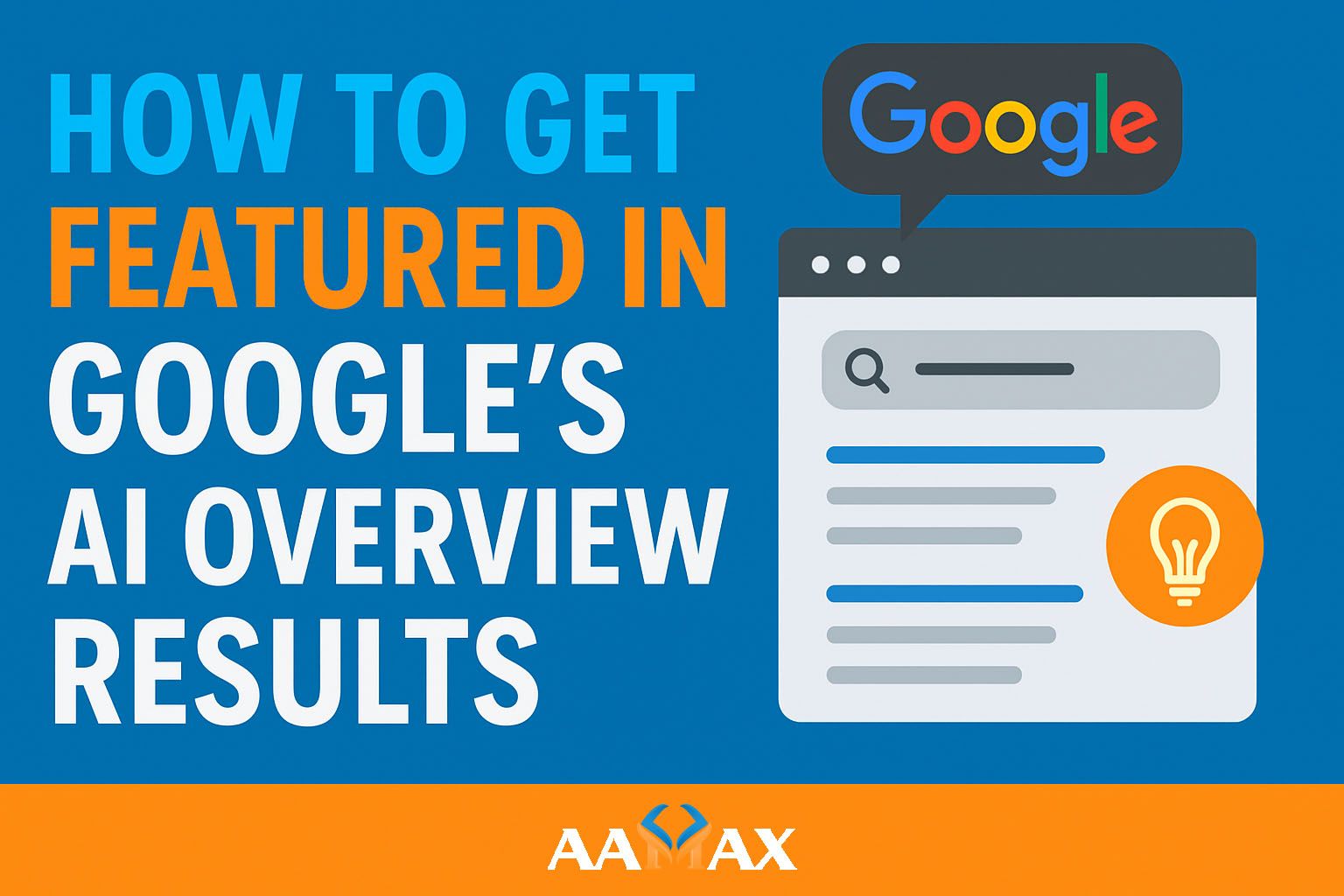
How to Get Featured in Google’s AI Overview Results
As Google continues to evolve its search experience, AI Overviews (previously known as Search Generative Experience or SGE) have become one of the most transformative updates in recent years. Instead of showing a list of blue links, Google’s AI Overview uses generative artificial intelligence to create concise, informative summaries drawn from multiple trusted sources across the web.
For content creators, marketers, and Search Engine Optimization (SEO) professionals, getting featured in Google’s AI Overview represents a huge opportunity. It’s the new frontier of visibility — a chance to be recognized by Google’s AI as a top source of credible, high-quality information.
In this comprehensive guide, you’ll learn exactly how AI Overviews work, what signals influence their content selection, and most importantly, how to optimize your website to get featured in these AI-generated summaries.
What Are Google’s AI Overview Results?
Google’s AI Overviews are enhanced search results powered by generative AI models such as PaLM 2 and Gemini. They appear at the top of search results pages and provide summarized answers to complex queries, complete with citations linking to the web pages used as references.
How It Looks:
When a user types a question like “What’s the best strategy for AI SEO?”, Google’s AI Overview might display:
- A short paragraph summarizing top insights
- Supporting links to original sources
- Optional “follow-up questions” that expand the topic
These AI-driven responses help users quickly understand a topic while still encouraging them to click for deeper information.
Why It Matters for SEO
Being cited in Google’s AI Overview can:
- Increase brand visibility
- Drive high-quality organic traffic
- Boost authority and trust in your niche
- Strengthen your overall SEO performance
AI Overviews are a new SEO goldmine — and understanding how they’re built is the first step to capturing that visibility.
How Google Chooses Content for AI Overviews
Google’s AI Overview system pulls information from multiple high-authority sources, synthesizing the data into one AI-generated response. The goal is to provide comprehensive, balanced, and factual information.
Here’s what influences the selection process:
- Relevance: The content must directly and clearly answer the query.
- Authority: Google favors trustworthy and expert-backed websites.
- Depth and Completeness: Pages that cover topics thoroughly are more likely to be cited.
- Clarity and Structure: AI systems prefer well-organized and scannable content.
- E-E-A-T Factors: Experience, Expertise, Authoritativeness, and Trustworthiness are critical.
In short, if your content is useful, original, and well-structured — and your website demonstrates authority — your chances of being featured increase significantly.
How to Optimize for Google’s AI Overview
Now that you understand how Google’s AI Overviews work, let’s explore the practical steps to improve your chances of being featured.
1. Understand Search Intent on a Deeper Level
AI Overviews are intent-driven. That means Google’s AI doesn’t just look for keyword matches — it looks for answers.
To optimize for this:
- Research what users truly want to know when searching for a given term.
- Use tools like ChatGPT, Google’s “People Also Ask,” and AnswerThePublic to identify intent.
- Focus on contextual depth — go beyond surface-level explanations.
For example, instead of writing “AI SEO tools list,” create content that explains why those tools matter, how they’re used, and which scenarios they fit best.
2. Create Comprehensive, Expert-Level Content
AI Overviews favor authoritative, well-rounded content that offers full context around a topic.
Best Practices:
- Write long-form, in-depth articles (like this one).
- Break down complex ideas into clear, digestible sections.
- Include examples, data, and expert quotes.
- Use tables, bullet points, and summaries for easy scanning.
- Incorporate FAQs to capture related subtopics.
Think of your article as a complete answer hub — one that Google’s AI could confidently summarize from.
3. Implement E-E-A-T Principles
Google’s AI systems rely heavily on E-E-A-T (Experience, Expertise, Authoritativeness, and Trustworthiness) to determine credibility.
How to Improve E-E-A-T:
- Highlight author credentials and include bios showing relevant expertise.
- Reference trusted sources and link to authoritative sites.
- Display reviews, case studies, or credentials if applicable.
- Keep your content factually accurate and regularly updated.
The stronger your perceived expertise, the more likely Google’s AI will use your content as a reliable reference.
4. Use Clear, Structured Formatting
AI systems prefer structure. Well-organized content is easier to interpret, extract, and summarize.
Optimization Tips:
- Use descriptive headings (H2, H3, H4) to define topics clearly.
- Keep paragraphs short and focused on one idea each.
- Add summary boxes, highlights, and numbered lists.
- Include schema markup to give Google more context about your content.
Structured content not only helps human readers but also assists Google’s AI in understanding relationships between topics.
5. Target Complex and Exploratory Queries
AI Overviews often appear for complex, multi-step, or informational searches — not simple fact-based ones.
Examples:
- “How to build an AI-driven content strategy.”
- “What’s the impact of AI on SEO ranking factors?”
- “Best practices for optimizing content for Google’s AI.”
To target these, create in-depth guides, how-to tutorials, and comparative analyses that go beyond surface-level answers.
Your goal: cover the why, how, and what next of a topic.
6. Add Structured Data and Schema Markup
Structured data helps Google understand your page contextually.
It’s not a direct ranking factor, but it improves how AI models interpret and cite your content.
Useful Schema Types:
- FAQ Schema: Helps your content appear in follow-up question boxes.
- HowTo Schema: Boosts chances of being featured in tutorials or guides.
- Article Schema: Identifies author, date, and credibility details.
- Organization Schema: Reinforces brand trust and authenticity.
By implementing schema, you give Google’s AI “clues” that improve your inclusion odds.
7. Optimize for Readability and Engagement
AI models favor content that users engage with — because engagement signals satisfaction and relevance.
How to Improve Engagement:
- Write in a natural, conversational tone.
- Use visual elements (images, infographics, charts).
- Add interactive content (videos, polls, or calculators).
- Include summaries or key takeaways at the end of major sections.
Engagement metrics such as dwell time and low bounce rates indirectly influence how AI evaluates your content quality.
8. Build Topical Authority and Content Clusters
Google’s AI identifies websites with semantic authority — meaning they publish multiple related pieces that cover a topic comprehensively.
How to Build Authority:
- Create content clusters around a main keyword or theme.
- Link all cluster pages internally using descriptive anchor text.
- Include a pillar page that acts as a central hub for the topic.
Example Cluster:
- “AI SEO Basics” (pillar page)
- “AI Tools for Content Optimization”
- “Understanding AI-Driven Keyword Research”
- “How Google’s AI Overviews Work”
This structure signals to Google’s AI that your website is a go-to resource for the topic.
9. Optimize Technical SEO and Performance
Even if your content is excellent, poor site performance can limit visibility in AI Overviews.
Technical Elements to Optimize:
- Core Web Vitals: Ensure pages load quickly and smoothly.
- Mobile Experience: Design responsively for all screen sizes.
- HTTPS Security: Trustworthiness matters.
- Crawlability: Fix broken links and simplify site structure.
AI systems rely on Google’s core indexing and ranking metrics, so technical excellence remains fundamental.
10. Leverage AI Tools to Improve Your SEO
To rank within Google’s AI Overviews, it makes sense to use AI for SEO optimization.
Recommended Tools:
- Frase – Content optimization and topic gap analysis.
- SurferSEO – Competitor SERP analysis and content scoring.
- ChatGPT / Gemini – Idea generation, title creation, and metadata drafting.
- MarketMuse – Semantic clustering and authority enhancement.
AI tools can help refine your content, identify missing elements, and align your SEO with Google’s evolving algorithms.
Measuring Success: How to Know If You’re Featured
Google is gradually rolling out Search Console metrics that include “AI Overview impressions.”
Until then, you can measure success by monitoring:
- Organic traffic changes after AI Overview updates
- Engagement and CTR improvements
- Third-party AI tracking tools (like SEOClarity and BrightEdge)
You can also manually search queries related to your content to see if your site appears as a cited source in the AI Overview box.
Common Mistakes to Avoid
- Keyword stuffing without context.
- Publishing low-value or duplicate AI-generated content.
- Ignoring structured data and page experience.
- Failing to demonstrate expertise or author credibility.
- Over-automation without human oversight and editing.
Remember — Google’s AI rewards quality, originality, and usefulness. Always review AI-assisted content to maintain a human touch and brand consistency.
The Future of SEO and AI Overviews
AI Overviews are part of a broader trend: AI-assisted search evolution. As these summaries expand globally, traditional SEO must adapt.
In the future, we’ll see:
- More personalized AI summaries based on user behavior.
- Voice-based AI results powered by natural conversation.
- Deeper integration of structured data into AI systems.
- Stronger reliance on semantic and contextual optimization.
Businesses that embrace AI SEO early will stay ahead as the search ecosystem evolves.
Partner with Experts to Get Featured in AI Overviews
Getting featured in Google’s AI Overview results requires a combination of technical SEO, high-quality content, and AI-aware optimization. If you’re serious about achieving this, working with a team that understands AI-driven SEO is essential.
Consider partnering with AAMAX — a full-service digital marketing company offering Web Development, Digital Marketing, and SEO Services.
AAMAX specializes in AI SEO strategies that help brands get recognized in Google’s AI Overviews, combining deep SEO expertise with modern AI integration.
Their team can help you:
- Create content structured for AI visibility.
- Optimize E-E-A-T signals for credibility.
- Implement technical and schema enhancements.
- Build a strong topical authority framework.
With AAMAX, you gain a partner who understands how to merge human creativity with AI precision to dominate the new era of intelligent search.
Final Thoughts
Getting featured in Google’s AI Overview results is one of the most powerful ways to grow your brand visibility and authority in the modern search landscape. It’s not just about keywords anymore — it’s about context, credibility, and comprehensiveness.
By understanding how AI Overviews work, optimizing your content strategically, and partnering with experts like AAMAX, you can position your website to thrive in the AI-powered future of SEO.
Start optimizing today — the future of search is already here.







